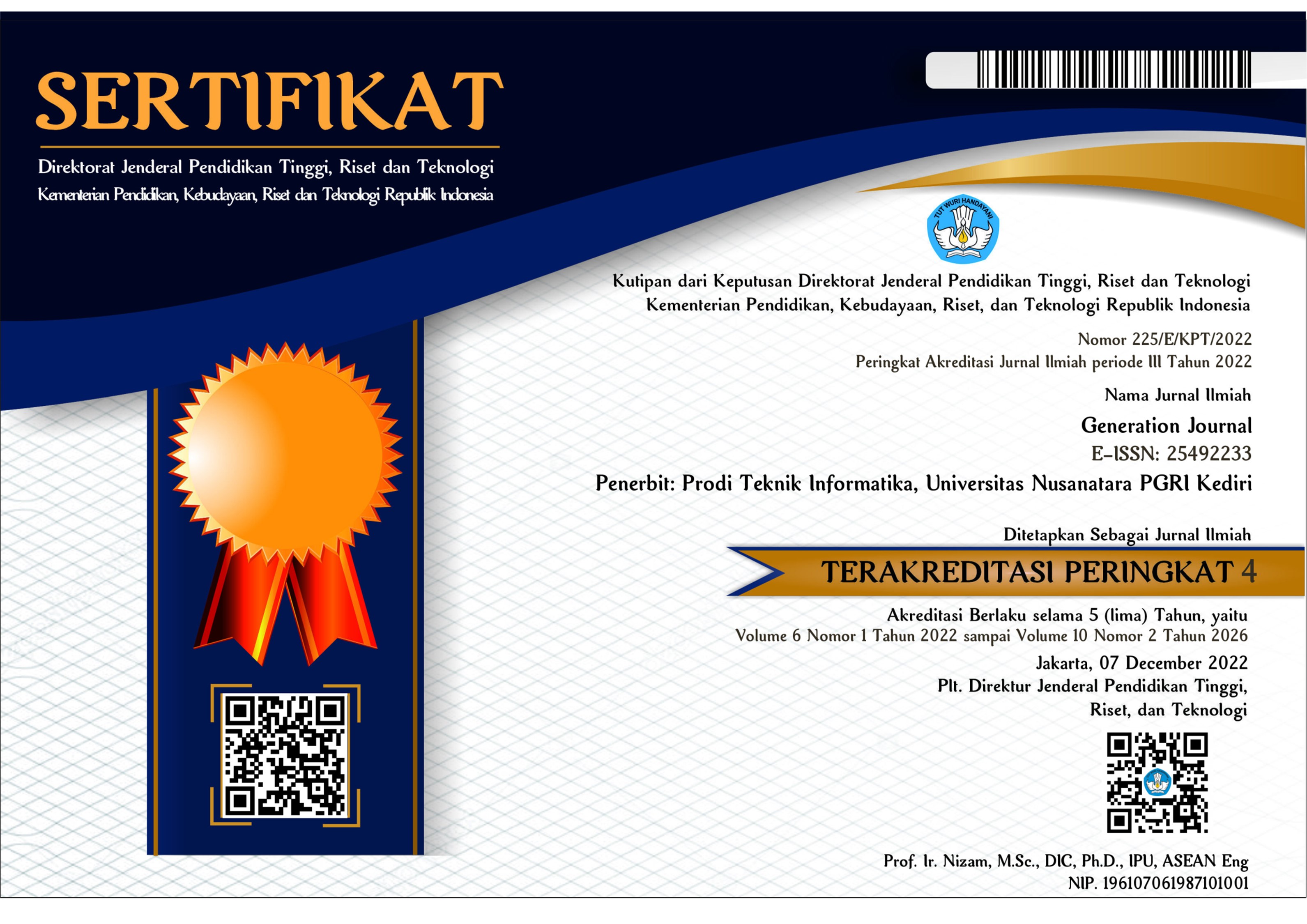Klasifikasi Jenis Buah Jambu Biji Menggunakan Algoritma Principal Component Analysis dan K-Nearest Neighbor
DOI:
https://doi.org/10.29407/gj.v7i1.17900Keywords:
Guava, K-Nearest Neighbor, Principal Component AnalysisAbstract
The maturity level of guava fruit can be determined by looking at various factors. Shape is one of the factors that play a role in identifying certain objects. The classification of guava fruit can be seen from the shape, texture and color. The shape of the guava fruit is quite diverse ranging from round (Round shape) to oval (Pear shape). So a Matlab application was built to determine the type of guava based on its color, shape and texture. K-Nearest Neighbor can classify objects based on learning data that is closest to the object so that the results can be more accurate. Principal Component Analysis (PCA) is a statistical technique for simplifying many-dimensional data sets into lower dimensions (extration features). The combination of K-Nearest Neighbor with Principal Component Analysis produces a fairly high accuracy for determining the type of guava using a total of 45 images and divided into two data including training data with a total of 36 guava data and test data with a total of 9 guava data.
References
P. Kedisiplinan, D. A. N. Motivasi, K. Terhadap, K. Karyawan, Y. Rahman, and A. Hakim, “Vol. 02, No. 01. Tahun 2017 ISSN 2540-959X,” vol. 02, no. 01, pp. 43–50, 2017.
M. Nanja and P. Purwanto, “Metode K-Nearest Neighbor Berbasis Forward Selection Untuk Prediksi Harga Komoditi Lada,” Pseudocode, vol. 2, no. 1, pp. 53–64, 2015, doi: 10.33369/pseudocode.2.1.53-64.
H. Surahman, A. Fuja, and I. Rubandi, “Pengenalan Jenis Pempek Menggunakan Metode Canny & K-Nearest Neighbor ( KNN ) Berdasarkan Bentuknya,” no. 14, pp. 1–11.
I. W. A. Heryanto, Artama, M. W. S. Kurniawan, and G. A. Gunadi, “Segmentasi Warna dengan Metode Thresholding,” Wahana Mat. dan Sains, vol. 14, no. 1, pp. 54–64, 2020.
H. Hsv and F. Astutik, “Implementasi Struktur Tree Pada Rancang Bangun Sistem Penelusuran Sejarah Pura Kawitan Dan Kahyangan Jagat Berbasis Web,” Lontar Komput. J. Ilm. Teknol. Inf., vol. 2, no. 1, pp. 336–346, 2011.
Herfina, “Pengenalan Pola Bentuk Bunga Menggunakan Principle Component Analysis,” Semin. Nas. Teknol. Inf. dan Multimed., no. 7, pp. 25–30, 2013.
Ananto, D.I., Murinto, (2015) Aplikasi Pengolahan Citra Mendeteksi Kualitas Cabai Berdasarkan Tingkat Kematangan Menggunakan Transformasi Warna Ycbcr, Jurnal Sarjana Teknik Informatika, Universitas Ahmad Dahlan. Vol. 3, No. 1, PP. 283-293.
Donowarti, I., Qomarudin, (2016) Pengembangan Metode Teknik Image Processing Untuk Pemutuan (Grading) Buah Pisang Cavendis Segar Secara Nondestruktif, Jurnal Ilmu-ilmu Pertanian, Universitas Wisnuwardhana Malang. Vol. 10, No. 2, PP. 130-143.
E. Budianita, J. Jasril, and L. Handayani, (2015) Implementasi pengolahan citra dan klasifikasi k-nearest neighbour untuk membangun aplikasi pembeda daging sapi dan babi, J. Sains dan Teknol. Ind., Vol. 12, no. 2, PP. 242–247.
Edha, H., Sitorus, H.S., Ristiani, U, (2020) Penerapan Metode Transformasi Ruang Warna Hue Saturation Intensity (Hsi) Untuk Mendeteksi Kematangan Buah Mangga Harum Manis, Jurnal Komputer dan Aplikasi, Universitas Tanjungpura, Vol. 08, No. 1. PP. 1-10.
Ferdiansyah, R.M., Firdausy, K., Sutikno, T, (2006) Sistem Seleksi Kematangan Buah Tomat Waktu-Nyata Berbasis Nilai Rgb, Telkomnika, Universitas Ahmad Dahlan. Vol. 4, No. 3. PP. 211-216.
Hidayat, F.I., Harahap, L.A., Panggabean, S, (2017) Identifikasi Kematangan Buah Jambu Biji Merah (Psidium Guajava) Dengan Teknik Jaringan Syaraf Tiruan Metode Backpropagation, Keteknikan Pertanian, USU Medan. Vol. 5 No. 4. PP. 826-835.
Indarto., Murinto, (2017) Deteksi Kematangan Buah Pisang Berdasarkan Fitur Warna Citra Kulit Pisang Menggunakan Metode Transformasi Ruang Warna HIS, Juita, Universitas Ahmad Dahlan. Vol. 5, No. 1, PP. 15-21.
Nurjanah, S, (2017) Pengenalan Nama Buah Berdasarkan Bentuk Dengan Menggunakan Metode Thresholding, Simki-Techsain, Universitas Nusantara Pgri Kediri. Vol. 01 No. 08. PP. 3-10.
Permadi, Y., Murinto, (2015) Aplikasi Pengolahan Citra Untuk Identifikasi Kematangan Mentimun Berdasarkan Tekstur Kulit Buah Menggunakan Metode Ekstraksi Ciri Statistik, Jurnal Informatika, Universitas Ahmad Dahlan. Vol. 9, No. 1, PP. 1028-1038.
Downloads
Published
Issue
Section
License
Authors who publish with this journal agree to the following terms:
- Copyright on any article is retained by the author(s).
- The author grants the journal, the right of first publication with the work simultaneously licensed under a Creative Commons Attribution License that allows others to share the work with an acknowledgment of the work’s authorship and initial publication in this journal.
- Authors are able to enter into separate, additional contractual arrangements for the non-exclusive distribution of the journal’s published version of the work (e.g., post it to an institutional repository or publish it in a book), with an acknowledgment of its initial publication in this journal.
- Authors are permitted and encouraged to post their work online (e.g., in institutional repositories or on their website) prior to and during the submission process, as it can lead to productive exchanges, as well as earlier and greater citation of published work.
- The article and any associated published material is distributed under the Creative Commons Attribution-ShareAlike 4.0 International License














